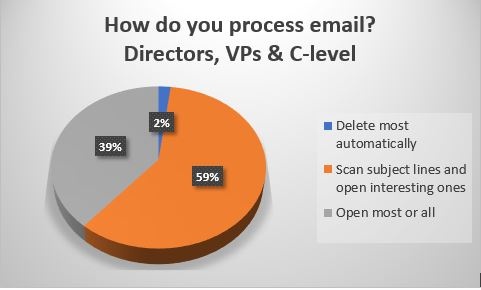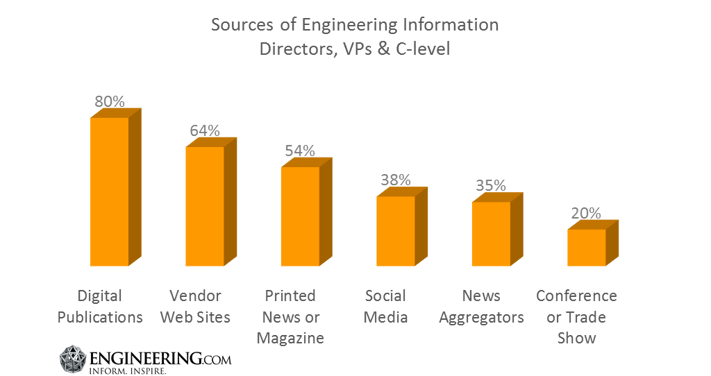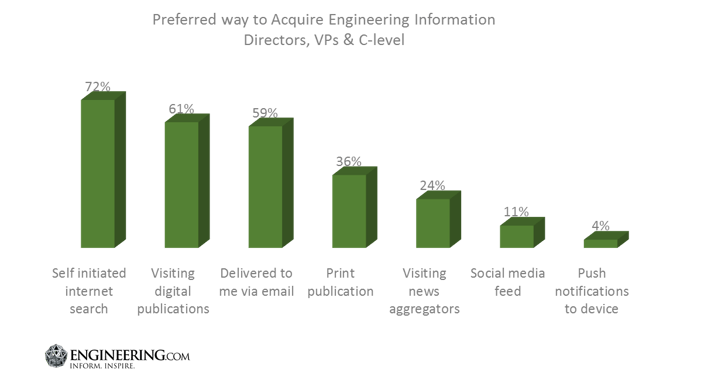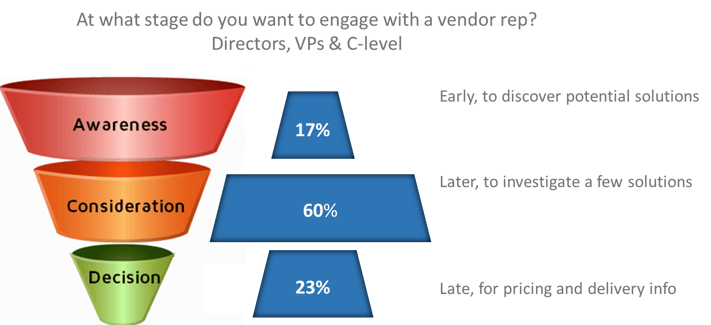Engineering marketers frequently say, “We need to reach decision makers with this campaign’” often because their sales teams tell them, “Whenever we get in front of a decision maker, we have a great shot at the sale, so let’s only talk to decision makers.”
As anyone who has run a campaign that targets decision makers knows, this is no easy road. We recently surveyed over 100 Director and CXO level engineers about their information consumption habits. This research shows how you can reach those decision makers.
Take email, for example. Do you think they read it? Well, they do.

98% of engineering directors, VPs and C-level respondents say that they at least scan the subject line of every email they receive. 98%! That’s huge. And 39% actually open most or all of the emails that you send. So that may leave you wondering why they don’t engage with your content and become active leads.
That has more to do with them than you.
How Senior Executives Gather Engineering Information
Those highly valued senior level contacts guard their time very carefully. They don’t respond to mass emails and they don’t return unsolicited phone calls. That doesn’t mean that your messages aren’t getting through.
The Directors, VPs and C-level engineers we surveyed said that their first choice for engineering information was digital publications, followed by vendor web sites and then print magazines. If you have strong SEO and are sponsoring content, chances are your content is being seen.

One really important take-away, however, is that 38% of these decision makers check their social media feeds. In all, these senior executives are voracious consumers of content. Most of them use multiple sources, so regardless of which media you are using, so long as you are using more than one, you stand a good chance of them seeing your message.
The second key finding is that they like email. Not only do they scan the subject lines, not only do they open it, but they actually prefer email. This chart shows you the content consumption preferences of senior engineering executives.

Like everyone else, their first choice when seeking engineering information is an internet search, followed by visiting digital publications. That means, no surprise, that your SEM and landing pages have to be top notch. This is not news. Nor is it surprising that you need to ensure that your company is covered in the relevant trade publications. What may surprise you is that almost 60% of these decision makers said that they preferred to receive their engineering information via email. This agrees nicely with the opening chart in this post that shows how decision makers treat those emails.
If your campaign is targeting decision makers, email is one of your most effective media options.
If your campaign is targeting decision makers, email is one of your most effective media options.
Why don’t Senior Executives Engage with Your Content?
Even with email, you are still likely to be disappointed in your campaign metrics. Click-throughs on your email and downloads from your landing pages won’t be very satisfying. That’s because senior executives are unlikely to engage directly. Instead, they ask somebody on their team to do the research for them, and then consider the results when they are closer to a decision point.
We asked senior executives at what stage in their buying journey they want to engage with a vendor representative. The answer was, “not at the awareness stage” (only 17% said then), but rather at the consideration stage or later.

This can prove to be a real dilemma for marketers. You may need a certain number of leads to meet your campaign objectives. That may push you to focus more on the top of the funnel. However, those leads aren’t ready to be contacted, so you will do your pipeline a disservice if you call these downloads “MQLs”.
In fact, you can waste a ton of internal resources by designating leads as MQLs only to find that they convert at less than, say, 5% when real MQLs should covert at more than 15%.
Typical Campaigns Structures Spell Disaster for Senior Executives
Let’s consider a typical campaign:
- Target audience: Director, VP & C-Level
- Content asset: White paper
- Buying stage: Awareness & Consideration
- Form fields: Name, email, company, telephone
- Next step: Call from inside sales rep to set an appointment
- Lead Qualification: Has budget, need, willing to accept a call from a sales rep
This structure is a disaster if you want to reach senior executives. The reason is that if they download the white paper, which few of them will do, it will be because they are truly interested in what you have to say. If you then have a relatively low-cost resource (inside sales rep) call to qualify them, you will be wasting their time. They will have real questions about applying your solution to their scenario. If the person who calls them can’t answer those questions, they may go away and never return.
If you actually have a shot at getting in touch with a senior executive, you need to put a professional sales person on that call, which means that you need to ask those sales resources to take on an activity that they don’t enjoy – calling non-qualified leads.
There are two other alternatives, and they are both good
First, you can nurture the senior executive lead further before you hand them over to sales. For example, your marketing automation can offer them additional assets that are designed for the consideration or decision making stage, such as product comparison tools or ROI calculators. If they access any of these, their lead score should make them a candidate to move to a senior sales resource.
Consider targeting the influencers to reach the senior engineering executive
Second, you can target the influencers in the prospect’s organization in addition to the senior executive. This allows the people who are doing most of the research anyway to be among the first to hear about a potential solution. This is a smoother and more natural way for information to flow.
Four takeaways to reach engineering decision makers
To recap, the next time you are thinking of targeting senior executives with a campaign, here are four things you can do:
- Target their support network as well
- Use email, industry publications (digital and some print) and social media
- Introduce live connections only when they reach the consideration stage
- Use high-level sales resources when making any live connection
That’s it for this topic. Please share with your colleagues if you deem it worthy.
Thanks,
John




